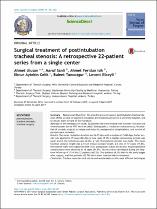| dc.contributor.author | Uluşan, Ahmet | |
| dc.contributor.author | Şanlı, Maruf | |
| dc.contributor.author | Işık, Ahmet Feridun | |
| dc.contributor.author | Aytekin Çelik, İlknur | |
| dc.contributor.author | Tunçözgür, Bülent | |
| dc.contributor.author | Elbeyli, Levent | |
| dc.date.accessioned | 2019-05-13T08:58:38Z | |
| dc.date.available | 2019-05-13T08:58:38Z | |
| dc.date.issued | 2018 | |
| dc.identifier.citation | Uluşan, A., Şanlı, M., Işık, A. F., Aytekin Çelik, İ., Tunçözgür, B., Elbeyli, L. (2018). Surgical treatment of postintubation tracheal stenosis: a retrospective 22-patient series from a single center. Asian Journal of Surgery, 41(4), 356-362. | en_US |
| dc.identifier.issn | 1015-9584 | |
| dc.identifier.uri | https://doi.org/10.1016/j.asjsur.2017.03.001 | |
| dc.identifier.uri | https://hdl.handle.net/11491/1172 | |
| dc.description.abstract | Background/Objective: We aimed to present cases of postintubation tracheal stenosis (PITS), all due to long-term intubation and treated surgically in a university hospital, and to discuss them in light of the literature. Methods: In this retrospective study, 22 patients who were treated with tracheal resection and reconstruction due to PITS were included. Demographics, intubation characteristics, localization of stenosis, surgical technique and material, postoperative complications, and survival of patients were recorded. Results: The mean intubation duration was 16.95 days with a median of 15.00 days. Collar incision was applied in 19 cases (86.4%); in two cases (9.1%) a median sternotomy incision was used; and in the remaining case (4.5%), a right thoracotomy incision was made. The mean tracheal stenosis length was 2.14 cm (mean excision length, 2.5 cm). In 17 cases (77.3%), the anterior walls were supported with vicryl (polyglactin) suture one by one. No postoperative complications were observed in 12 cases (54.5%). No recurrence developed during the long-term follow-up of 15 of the 22 patients (68.2%). Two patients (9.1%) died in the early stages after surgery, and five patients (22.7%) had a stent inserted due to restenosis. Conclusion: Tracheal resection and end-to-end anastomosis are the most efficient techniques in cases without medical contraindications, despite emerging stent or endoscopic procedures. Endoscopic interventions can be suggested as an alternative to surgery in patients for whom surgery cannot be performed or who develop recurrence. © 2017 | en_US |
| dc.language.iso | eng | |
| dc.publisher | Elsevier | en_US |
| dc.relation.isversionof | 10.1016/j.asjsur.2017.03.001 | en_US |
| dc.rights | info:eu-repo/semantics/openAccess | en_US |
| dc.rights.uri | https://creativecommons.org/licenses/by-nc-nd/4.0/ | * |
| dc.subject | Postintubation | en_US |
| dc.subject | Tracheal Stenosis | en_US |
| dc.subject | Tracheal Surgery | en_US |
| dc.title | Surgical treatment of postintubation tracheal stenosis: a retrospective 22-patient series from a single center | en_US |
| dc.type | article | en_US |
| dc.relation.journal | Asian Journal of Surgery | en_US |
| dc.department | Hitit Üniversitesi, Tıp Fakültesi, Cerrahi Tıp Bilimleri Bölümü | en_US |
| dc.identifier.volume | 41 | en_US |
| dc.identifier.issue | 4 | en_US |
| dc.identifier.startpage | 356 | en_US |
| dc.identifier.endpage | 362 | en_US |
| dc.relation.publicationcategory | Makale - Uluslararası Hakemli Dergi - Kurum Öğretim Elemanı | en_US |



















